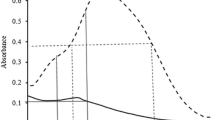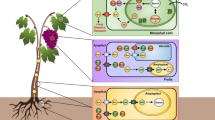Summary
Detectable breakdown of tuber starch and protein occurred some time after sprout emergence (planting depth 15 cm), and the rate of hydrolysis was independent of the number of sprouting eyes present. Reserve breakdown was first seen around regions of inner phloem, the zone of depletion subsequently spreading throughout the perimedulla. Tissue external to the vascular ring was depleted at a later date.
Zusammenfassung
Kinetik und makroskopische Verteilung des Stärke- und Proteinabbaues wurden an keimenden Knollen der Sorte Maris Piper untersucht. Dazu wurden zwei Serien von Knollen vorbereitet, eine Reihe mit einem keimenden Auge, die andere mit drei keimenden Augen, die anderen Augen wurden entfernt. Die Knollen wurden in feuchten Kompost bei 15°C im Dunkeln gepflanzt und in regelmässigen Intervallen innerhalb von 4 Monaten geerntet. Während dieser Periode erreichten die Keime beider Serien ein Gesamttrockengewicht von ungefähr 50% des Knollentrockengewichtes zum Zeitpunkt des Pflanzens. Wurde die Zunahme des Keimtrockengewichtesauf das Auge bezogen, so ergab sich eine Abnahme des Keimtrockengewichtes mit zunehmender Augenzahl (Abb. 1). Die Keime stehen daher in Konkurrenz zu den verfügbaren Reserven. Die Bedeutung dieser Konkurrenz nimmt mit der Zeit zu.
Bei einer Pflanztiefe von 15 cm erschienen die Keime nach 20 Tagen, ein erkennbarer Zusammenbruch von Stärke- und Proteinreserven in den Knollen konnte aber erst weitere 20 Tage später beobachtet werden (Abb. 2a und b). Nach 120 Tagen betrugen die Stärke- und Proteingehalte nur noch 10% der ursprünglichen Gehalte, aber es zeigte sich kein überein-stimmender Einfluss der Zahl der keimenden Augen pro Knolle auf die Abbauraten der beiden Reservestoffe. Für vor und innerhalb des Gefässbündelringes gelegenes Gewebe waren die Abbauraten ähnlich aber die Stärke-und Proteingehalte waren im Gewebe vor dem Gefässbündelring beträchtlich höher. Unterschiede in den Stärkegehalten dieser beiden Gewebe spiegelten den Intraknollengradienten im Trockenmassegehalt wieder und nicht Unterschiede im Prozentsatz der Trockenmasse verursacht durch Stärke (Tab. 1).
Das Muster des Reservestoffabbaues wurde an 1 mm dicken Längs- und Querschnitten durch die Knollenmitte histochemisch unter-sucht. Der Abbau von Stärke und Protein begann in der Perimedulla in der Nähe des Gefässbündelringes in Zonen, die mit der Verteilung des inneren Phloems übereinzustimmen schienen (Abb. 3 und 4). Die Abbauzone breitete sich dann in der gesamten Perimedulla aus. Das Gewebe vor dem Gefässbündelring zeigte als letztes den Abbau und auch hier ergaben sich Hinweise, dass der Abbau in den Phloemzonen erfolgte.
Résumé
La cinétique et la répartition macroscopique de la dégradation de l'amidon ainsi que des protéines sont étudiées au cours de la germination des tubercules de la variété Maris Piper. Deux lots de tubercules sont préparés. l'un composé de tubercules n'ayant qu'un seul germe et l'autre de tubercules porteurs de 3 germes. Les germes non désirés sont retirés. Les tubercules sont plantés dans un compost humide à 15°C, à l'obscurité puis prélevés régulièrement durant une période de 4 mois. Au delà de cette période, les germes des tubercules des deux lots atteignent un poids sec total d'environ 50% du poids sec des tubercules à la plantation. Lorsque l'accumulation du poids sec est exprimée en poids par germe, l'augmentation du nombre de germes réduit le taux de poids sec accumulé (fig.1). Ceci montre que les germes sont en compétition, quant à l'utilisation des réserves disponibles. L'importance de cette compétition augmente dans le temps.
Four une plantation à 15 cm de profondeur, l'émergence des germes a lieu après 20 jours, mais la chute du taux d'amidon et des réserves en protéines n'est observée de façon notable qu'une vingtaine de jours plus tard (fig. 2a et 2b). Après 120 jours, les taux de protéines et d'amidon sont réduits à environ 10% des taux initiaux et l'augmentation du nombre de germes par tubercule n'entraine aucune diminution décelable de ceux-ci. Des taux similaires de dégradation sont apparus dans les tissus situés des deux côtés de l'anneau vasculaire mais la teneur en amidon et en protéines est plus élevée dans le tissu externe. Des différences de teneurs entre ces tissus reflètent le gradient de matière sèche à l'intérieur du tubercule mais pas les différences du taux de matière sèche expliqué par l'amidon (tabl. 1).
Une analyse histochimique de la localisation de la dégradation des réserves est réalisée à partir de coupes longitudinales et transversales d'l mm d'épaisseur prélevées dans la partie centrale du tubercule. La dégradation de l'amidon et des protéines commence dans la zone périmédullaire adjacente à l'anneau vasculaire, sous forme de taches qui semblent coïncider avec le phloème interne (fig. 3 et 4). La zone de dégradation s'étend ensuite à travers toute la zone périmédullaire. Le tissu extérieur à l'anneau vasculaire subit cette dégradation en dernier, celle-ci apparaissant également au niveau du phloème.
Similar content being viewed by others
References
Bailey, K. M., I. D. J. Phillips & D. Pitt, 1978. The role of buds and gibberellin in dormancy and the mobilization of reserve materials in potato tubers.Annals of Botany 42: 649–657.
Davies, H. V. & P. T. Slack, 1981. The control of reserve mobilization in seeds of dicotyledonous plants.New Phytologist, 88: 41–51.
Edelman, J. & S. P. Singh, 1966. Studies on the biochemical basis of physiological processes in the potato tuber. Changes in carbohydrates in the sprouting tuber.Journal of Experimental Botany, 17: 696–702.
Edelman, J., T. G. Jefford & S. P. Singh, 1969. Studies on the biochemical basis of physiological processes in the potato tuber. The pathway and control of translocation from the tuber.Planta 84: 48–56.
Emilsson, B., 1949. Studies on the rest period and dormant period in the potato tuber.Acta agricultura suecana, 3: 189–282.
Hartmans, K. J. & A. Vanes, 1979. The influence of growth regulators GA3, ABA, kinetin and IAA on sprout and root growth and plant development using excised potato buds.Potato Research 22: 319–332.
Klein, L. B., S. Chandra & N. I. Mondy, 1982. Sprouting of potatoes: compositional changes in light and dark.Journal of Food Biochemistry 6: 97–109.
Lloyd, J. B. & W. J. Whelan, 1969. An improved method for enzymic determination of glucose in the presence of maltose.Analytical Biochemistry 30: 467–470.
Rappaport, L. & O. E. Smith, 1962. Gibberellins in the rest period of the potato tuber. In: R. Knapp (Ed.), Eigenschaften und Wirkungen der Gibberelline, Springer-Verlag, Heidelberg, p. 37–45.
Reeve, R. M., E. Hautala & M. C. Weaver, 1970. Anatomy and compositional variations within potatoes. III. Gross compositional gradients.American Potato Journal 47: 148–162.
Sedmak, J. J. & S. E. Grossberg, 1977. A rapid, sensitive, and versatile assay for protein using coomassie billiant blue G250.Analytical Biochemistry 79: 544–552.
Sharma, M. K., D. R. Isleib & S. T. Dexter, 1958. Specific gravity of different zones within potato tubers.American Potato Journal 35: 784–788.
Szalai, I., M. Nagy & M. Helfrich, 1975. What is the possible role of gibberellin in the breaking of potato dormancy? I. Physiological effects of GA3 on carbohydrate metabolism, amylase activity and respiration in sprouting potato.Acta agronomica Academiae scientiarum hungaricae 24: 335–342.
Thompson, R. & H. Taylor, 1979. Field plots for the practical estimation of potential yield.Scientia horticulturae 10: 309–316.
Author information
Authors and Affiliations
Rights and permissions
About this article
Cite this article
Davies, H.V., Ross, H.A. The pattern of starch and protein degradation in tubers. Potato Res 27, 373–381 (1984). https://doi.org/10.1007/BF02357425
Accepted:
Issue Date:
DOI: https://doi.org/10.1007/BF02357425




